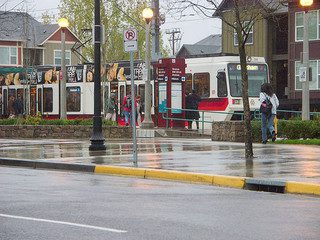
• Not in My Backyard (NIMBY) opposition to affordable housing development.
• Gentrification that displaces low- and moderate-income households from neighborhoods just as the neighborhoods are starting to strengthen.
Given the prominence and seeming intractability of these concerns, you would think that a new federal policy that addresses them would be Headline News across all major affordable housing channels. But with a few notable exceptions, this policy change seems to be largely flying under the radar.
The new federal policy is one that, for the first time, provides tangible financial incentives for local communities to preserve affordable housing near planned transit stations and ensure that any new development in these areas includes housing affordable to low- and moderate-income households.
The new incentives come through changes to the criteria for awarding federal New Starts grants for new and expanded public transit lines to give extra points in the “economic development” section of the competition to communities that adopt and implement housing policies to achieve these goals. The new policy also creates incentives in the “land use” section of the competition for communities to choose transit alignments that serve neighborhoods that include subsidized housing.
The Federal Transit Administration (FTA) just finalized the policy guidance that sets the specific criteria for evaluating the housing policies and transit alignments proposed by New Starts applicants. The final rule announcing the policy in broad terms came out earlier in the year.
How would the new policy address concerns about NIMBY and gentrification?
• NIMBY: One of the biggest challenges in countering NIMBY opposition to affordable housing is that there are few adverse consequences to blocking development. Yes, in extreme cases, you can lose your federal housing funds or be sued for failing to affirmatively further fair housing. But these cases tend to be rare, and many local actors feel they can block affordable housing development without fear of consequences.
The newly announced changes to the New Starts program help to change this calculus. Now, advocates and practitioners seeking to preserve or expand affordable housing near planned transit stations can credibly say that there’s real money at stake in the form of large New Starts grants that fund new transit lines or expansions. Sure, affordable housing is not the only criterion in the competition, but at least it’s one of them, creating the space for a different conversation with local government and citizens about the mutual benefits of coordinated housing and transit investments.
• Gentrification: While the introduction of public transit does not always lead to rent and housing price increases, research suggests that it often has this effect, particularly in strong markets that feature comprehensive public transit systems that effectively link people to employment centers and other key destinations. To ensure that households of all incomes can afford to live in high-demand areas near transit, it’s important for communities to plan for the preservation of existing affordable homes and the inclusion of affordable housing within any new development near planned transit stations. The New Starts rules provide an incentive to do just this.
At the same time, as the FTA observed in adopting the new policy, these affordable housing incentives increase the likelihood that the low-income households that are most likely to utilize public transit can afford to live nearby, facilitating equitable access to transit and boosting ridership.
It remains to be seen how this new policy plays out in practice. Will applicants for New Starts grants work collaboratively with local stakeholders to develop creative, effective and comprehensive strategies for housing inclusion? Or will they simply describe existing (and largely insufficient and disconnected) housing efforts in glowing terms and hope they get the full score? And will the reviewers scoring the applications be able to tell the difference?
As these questions suggest, this new policy is unlikely to be self-implementing. Many communities will need guidance on how to develop effective affordable housing strategies linked to planned transit stations and assistance assembling the different components of a comprehensive strategy and partners to implement it. By reaching out to communities or regions applying for New Starts grants and offering to help them develop these new housing strategies, local practitioners and advocates can increase the odds that the plans are comprehensive and effective.
Where this collaborative approach doesn’t work, the New Starts funding criteria could also be used as a hook for local advocacy efforts designed to help ensure the adopted housing policies are robust and effective in ensuring households of all incomes can afford to live near planned transit stations.
A framework is now in place for improved coordination of housing and transportation policy to advance shared goals. Now the hard work begins of making it work!
(Photo by George Goodman CC BY-NC-ND)





Comments